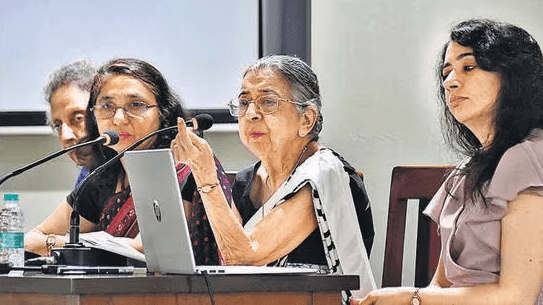The Esplanade area was still a blueprint when Muncherji Cowasji Murzban arrived in Bombay in 1863
MUMBAI: The Esplanade area was still a blueprint when Muncherji Cowasji Murzban arrived in Bombay in 1863. A protégé of Sir Bartle Frere, the governor of Bombay who pulled down the ramparts of the old fort to make way for Churchgate as we know it today, Murzban was originally a civil engineer in Poona. In his Bombay stint, he ended up not just designing buildings, but also designing the city, when he rose to the position of executive engineer of the Municipal Corporation of Bombay in 1892.
Article By Ekta Mohta | Hindustan Times
Mumbai, India – May 10, 2023: Research scholar Professor Aban Zarir Sethna delivers her lecture on “Khan Bahadur Muncherji C. Murzban – Unsung ‘Native’ Architect of Bombay, 1839-1917”, during the Gulestan and Rustom Billimoria Memorial Lecture, organised by K.R. Cama Oriental Institute, at Dr. Sir J.J. Modi Memorial Hall, Fort, in Mumbai, India, on Wednesday, May 10, 2023. (Photo by Bhushan Koyande/HT Photo) (HT PHOTO)
On Wednesday evening, at the KR Cama Oriental Institute, Prof Aban Zarir Sethna presented a lecture on the life and contribution of Murzban. Sethna, who taught at Sir JJ College of Architecture for 30 years, said, “I’m here today to talk about an illustrious Parsi gentleman, who is little known to us. Khan Bahadur Muncherji Cowasji Murzban was an unsung ‘native’ architect of Bombay.”
Born on July 7, 1839, Murzban was a graduate of Poona Engineering College, who joined the Public Works Department (PWD) in 1856. He worked on plans for the hydraulic works in Poona, and on the construction of roads, barracks and bridges. “He would have remained, or rather languished, in Poona, if not for a chance opportunity,” said Sethna. On Frere’s recommendation, he was appointed assistant to the secretary of the Rampart Removal Committee in 1863, where he assisted in reclamations. “It is rightly said that reclamations have made Bombay,” said Sethna. “The area from Radio Club to the Taj Mahal Palace sits on land reclaimed by him.”
Engineer-cum-architect
Going through his archives today, Murzban’s portrait reveals an angular, wizardly face, with round glasses, a shaggy beard, and a Parsi turban. Between 1872 and 1892, he was the superintendent of 27 public buildings, and designed 12 of them. “He was basically a civil engineer, and not an architect by training,” said Sethna. It is a measure of his proficiency in both that he was made a fellow of Royal Institute of British Architects in 1889.
To illustrate his knack at solving structural problems, Sethna narrated a story. “The General Post Office (GPO) in Fort was constructed based on designs sent by England. It was designed in a way that the weight of the two upper floors was to fall on the substructure of the ground floor, composed of columns and arches. Murzban had alerted his superior on the inherent weakness of the under-structure. As he expected, one stone pillar developed a vertical crack after completion. Soon, several other columns were discovered with fractures. There were dark whispers in the city that the GPO was falling down. It was decided that the eight columns would be replaced with columns of a bigger diameter, and Murzban was placed in charge. He finished the work without causing a single crack in any part of the building.”
Another landmark he supervised was Sir JJ School of Art. “Today, most public projects go through cost overruns. But, for Sir JJ School of Art, he saved ₹ 14,023 between the estimated and actual cost. It speaks volumes of his integrity and loyalty to the crown.” It was for this reason that in 1877, at the Delhi Durbar, Murzban was awarded the title of Khan Bahadur.
Of the dozen buildings he designed, almost all are in the neo-Gothic style. Sethna said, “St Francis Xavier’s Church in Kalbadevi is a great stone building, with stained-glass windows and a stunning wooden roof. The Cama Hospital looks like a British mansion, with a geometric pattern on the grillage, which spiced up the entrance, and a beautiful latticed wrought-iron grille on the rear side. The Parsee Lying-in Hospital was asymmetrically planned, while still retaining its balance. Intricately carved jalis let in the right amount of light in the entrance lobby.” One exception was the Petit Gym in Khetwadi. “For this, he abandoned the high-flying Gothic style and created a simple, earthly structure with a vernacular touch. It is still in use in the present day.”
After 36 years in the PWD, he was appointed executive engineer of the Municipal Corporation of Bombay in 1892, a position he held for 11 years. Jamsetji N Tata had proposed his name for the position, and Sir Pherozeshah Mehta had backed his election, which he won against an Englishman. “As the first Indian elected to this position, it was seen as a victory for local self-government,” said Sethna. During his tenure, the four areas in which he had a far-reaching impact were waste disposal, improvement of insanitary houses and slums, street lighting, and housing for the poor. It was on his direction that the landfill was shifted from Mahalaxmi to Deonar, seven miles away from human habitation.
It is a pity that more than a hundred years later, we have still not been able to improve on his blueprints for the city.

